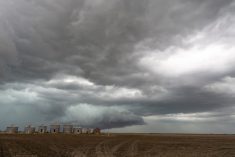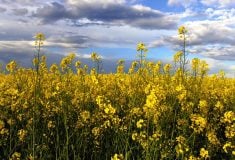CNS Canada –– Over the next month, Prairie producers can expect to see more of the cool, wet weather that has afflicted much of Western Canada so far this spring, according to a weather expert.
“We’ll keep a cooler bias relative to normal over these next few weeks. So the drying rates will be a little sluggish for a while yet, but we will have some warmer days, it’s not a total disaster,” said Drew Lerner, president and meteorologist for World Weather Inc. in Kansas City.
Read Also

Sigurdson applauds Alberta farmers
With Alberta’s harvest virtually wrapped up for 2025, provincial Agriculture Minister RJ Sigurdson offered the government’s congratulations to the province’s farmers.
Overnight lows are still below 0 C in many locations and already some weather-watchers are drawing comparisons to the spring of 2011, which to Lerner, isn’t a good sign.
Lerner said he believes May will be cooler than normal with regular bouts of precipitation, but doesn’t expect it will translate into any sustained periods of intensive rain.
“It won’t stay warm, we’ll probably wind up with more coolness and shower activity towards the end of the month.”
The cool spring is all part of an 18-year cycle and will keep producers from getting into the field as quickly as they’d like, he said.
Lerner’s forecast is similar to the one found in a recent report from Environment Canada. The federal agency’s most recent three-month outlook calls for below-normal temperatures across all three Prairie provinces through May, June and July.
Heading into the summer, Lerner said he expects conditions to stay mild across the Prairies with the possible exception of the west.
“Now the western side, I think it’s different, I think they will heat up at some point in late summer. They will probably go a little too dry and warm in some parts of Alberta.”
This doesn’t mean the rest of the Prairies won’t see any warm weather during the spring or early summer, Lerner said; it simply means every time things warm up, they will quickly cool down again.
“We’re not going to have a tremendous amount of heat units in Manitoba or eastern Saskatchewan.”
Precipitation problem
As a result, he said, it will be difficult to get averages to the point where producers typically want them to be.
“Obviously we’re going to be running late on planting and degree-day accumulations so these crops will be a little bit more immature in the fall, and that raises a whole other issue, with possible frost freezes at the end of the season.”
In the near term, Lerner said, the precipitation western provinces have experienced is starting to become a problem. Water has pooled in many fields leaving producers unable to do fieldwork.
“We need to see significant days in a row of warm weather and no rain so that we can get rid of the surface moisture and start working the fields.”
— Dave Sims writes for Commodity News Service Canada, a Winnipeg company specializing in grain and commodity market reporting.















